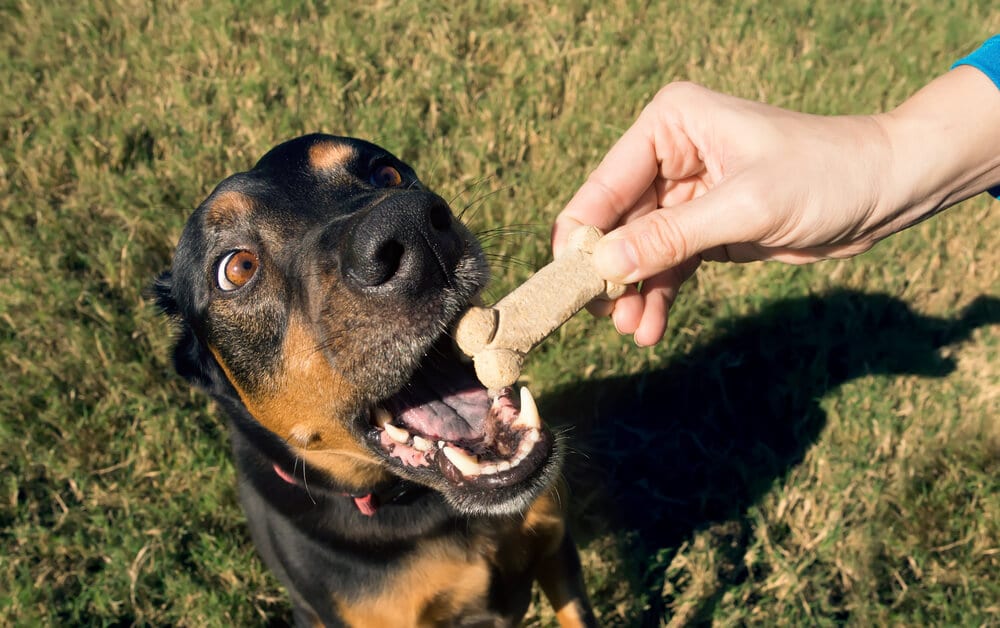When we humans develop a food allergy, it can be easy to detect if we are relatively healthy. We can tell someone we are feeling itchy, or have inflamed skin, or we are vomiting. But when your pet has a food allergy, it can take longer than usual to figure out what exactly is making them itch or swell. Food allergies can occur when your animal’s immune system identifies food as an invader and therefore constructs an immune response, such as swelling, vomiting or itching. Your pet’s allergies may have everything to do with the food and treats they are consuming, and absolutely nothing to do with the fact they spend all their time rolling in the grass outside. So, what do pet treats, and specifically natural pet treats, have to do with this? A lot more than you think, and it starts with the ingredients of what you’re currently feeding your pet! Natural pet treats in conjunction with a natural raw food diet can have a dramatic impact on your pet’s allergies.
Common pet allergies
Wheat
This is one of the most common food allergies! Wheat allergies can cause itchy red skin, ear infections, hair loss, obsessive licking and inflamed paws. Wheat is also known as gluten and includes any grains such as wheat, rye, barley, oats, rice, amaranth, buckwheat, corn, millet and certain beans. Gluten is often used in conjunction with soy as a filler in commercial pet foods, filling up your pet with nutrition-free empty carbs,
Soy
Just like humans, soy is a food that can have varying opinions. For pets, some studies have found soy can cause reproductive and growth hormones, among many other issues. Some vets recommend avoiding soy altogether whether your pet is allergic or not.
Beef
Proteins are a more common food allergy than you may assume. Beef can be one of the most common ingredients in pet food and pet treats. If your pet is allergic to beef, try another source of protein, like kangaroo treats.
Dairy
Just like humans, lactose intolerance in pets can lead to gas, diarrhoea and vomiting. However, there is a distinct difference between a dairy allergy and lactose intolerance in dogs. If your pet has skin itchiness, this could be an allergy, while lactose intolerance will become known through digestion issues.
Preservatives & Chemicals
Additives, preservatives, chemicals, MSG and flavour enhancers can be added into commercial dog food, and can take many shapes. ‘Vegetable protein, ‘yeast extract’ and ‘ribonucleotides’ are just a few ingredients that will tell you the food your pet is eating isn’t natural. Sulphites are also often used to make old meat look and smell fresh. You can find a typical ingredient list of a popular treat on supermarket shelves below.

Dogs go whacko: which of these ingredients can you confidently identify?
How do I know which food is the culprit?
While there are many medications you can put your pet on which can allow them to continue eating the food they are allergic to without the symptoms, it’s much safer for your pet to try an elimination diet trial. This involves trying new food that your pet hasn’t eaten before for six to eight weeks. Alternatively, we recommend switching your pet’s diet to a raw natural pet food diet, including natural treats. This is because natural treats and raw pet food have limited-ingredients, ingredients you can pronounce, none of the nasty elements previously mentioned, and are baked or dehydrated with your pet’s health in mind. If your pet is allergic to multiple foods found in commercial pet treats, natural pet treats in conjunction with a raw food diet could kill more than two birds with one stone. Just make sure you transition your pet according to our transition guide.
What is it about natural pet treats that can eliminate allergies?
Limited-ingredients
Choosing pet treats with limited-ingredients ensures you know exactly what is going into your pet’s body. Limited-ingredient natural pet treats also allows you to easily identify what your pet is reacting to. Our favourite limited-ingredient treats are our one ingredient treats such as pigs ears, dried sardines, kangaroo chops, kangaroo tendons, and chicken hearts – just to name a few! All of these treats are exactly what they say they are – no hidden additives, gluten, soy or chemicals. Go ahead, read the ingredients of your pet’s current treats, and you’ll know what we are talking about!
Different meats to choose from
Once you have transitioned your pet to a raw food diet, switching between different natural pet treat’s proteins will become a breeze. As previously mentioned, beef can be a more common food allergy than you may think; Drool Pet Co offers a wide range of different proteins to avoid flaring up your pet’s beef allergy, such as kangaroo treats which are known to be hypo-allergenic.
Naturally dehydrated
A treat’s cooking process can also trigger an allergic reaction in your pet even if they aren’t allergic to a specific ingredient. The way a treat is cooked, dehydrated or preserved can change the way your pet processes the ingredient. Luckily, Drool Pet Co’s natural dog treats are naturally dehydrated with a low-temperature dehydration process, and our baked treats are made in small batches to ensure complete control over the ingredients and cooking process.
Pronounce the ingredients
Our natural pet treats that contain more than one ingredient all contain ingredients you can pronounce. Our antler biscuits are a perfect example of this, containing wholemeal flour, coconut flour, polenta, psyllium husk, eggs, honey, ground deer antler and ground shark cartilage. No steroids, no by-products, no preservatives, no grains or soy. Our ingredients are also unique, making it easy to identify any ingredients that could amount to an allergy.
In short, natural pet treats have the power to eliminate your pet’s food allergies. Our 100% preservative-free and natural, naturally dehydrated and handmade treats do not contain any grains, soy, dairy or preservatives which are often found in commercial pet treats. If natural pet treats in conjunction with a raw food diet do not relieve your pet’s symptoms, we recommend seeing your local veterinarian.







Leave A Comment